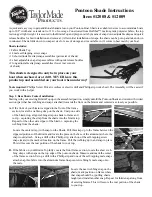
1xEV-DO Measurements
R&S
®
CMW-KG8xx/-KM8xx/-KS8xx
270
User Manual 1173.9511.02 ─ 11
To obtain meaningful OLTR results, the following conditions have to be met:
●
a stable connection between BS (R&S
CMW) and DUT is established
●
the DUT's transmission is "continuous"
●
in the absence of power steps, the DUT's Tx power would be (almost) constant
The standard recommends a loopback service for 1xRTT and a reverse test applica-
tion session with constant data rates (payload size, termination target) for 1xEV-DO.
See 3GPP2 C.S0011 and C.S0033 for details.
3.2.9.2
OLTR: Combined Signal Path Measurement
With open loop power control, the DUT will try to keep the sum of input and output
power constant, i.e. to increase/decrease its output power to the same extent as the
BS power UP/DOWN step; see 3GPP2 C.S0011 for a precise description of the
"Range of Open Loop Output Power".
The signaling application provides a dedicated "OLTR logic" that is activated with the
OLTR measurement.
To obtain meaningful OLTR results in combined signaling mode measurements, the
following strategies and settings are recommended:
●
in the signaling application, establish an adequate connection between R&S
CMW
and DUT:
–
use the reverse test application with constant data rates and packet sizes (min
== max) to obtain a signal with stable power level
–
use a step size
≤
30 dB
–
set the BS output power in a range such that the resulting power steps are
within the dynamic range of both DUT and R&S
CMW
●
in the measurement application,
–
select the "Combined Signal Path" scenario, controlled by the signaling appli-
cation
–
select "...: Event" as trigger source
–
configure and start the OLTR measurement
General Description
深圳德标仪器
135-1095-0799
















































